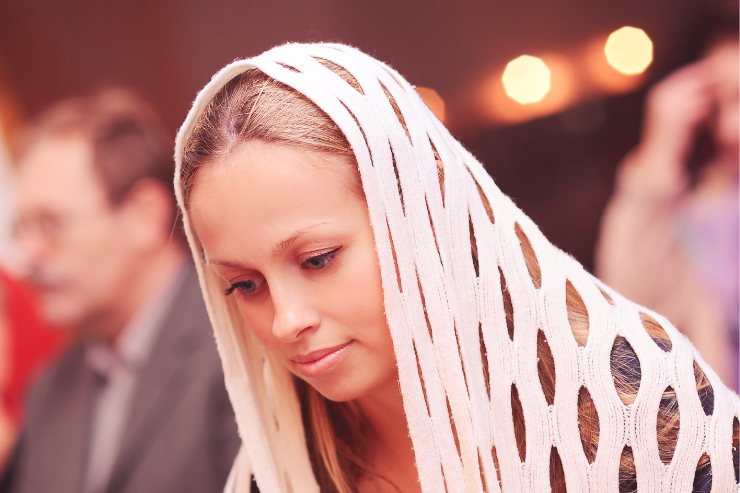 Years ago during my single college days (when I was a daily Mass goer), I was captivated by the few women who wore mantillas. That interest led me to consider veiling, but it was a transitory thought that was never truly discerned. I admired the women who were unafraid to stand out among the crowd at Mass, and something seemed sublimely delicate about their head coverings. It wasn’t just the covering itself, but rather it was the woman behind the veil. It was as if she was the mystery cloaked behind a lacy curtain so that she might more intimately enter into the Sacrament with Jesus, her Lover.
Years ago during my single college days (when I was a daily Mass goer), I was captivated by the few women who wore mantillas. That interest led me to consider veiling, but it was a transitory thought that was never truly discerned. I admired the women who were unafraid to stand out among the crowd at Mass, and something seemed sublimely delicate about their head coverings. It wasn’t just the covering itself, but rather it was the woman behind the veil. It was as if she was the mystery cloaked behind a lacy curtain so that she might more intimately enter into the Sacrament with Jesus, her Lover.
Wearing a mantilla was mandatory during pre-Vatican II days. My mom explained that any girl at her Catholic high school who “forgot” her mantilla was given a Kleenex-like, paper thin cloth to use when the students entered the chapel for Mass. Like most traditional practices, I wondered if somehow head coverings for women became lost in translation once Vatican II was implemented. Veils by Lily offers gorgeous postcards in full color that succinctly explain this practice for those who are inquisitive to understand this practice. On one of the cards, they state that “Vatican II never did away with this tradition. It remains a beautiful devotion whereby each woman, symbolizing the Bride of Christ, the Church, wears a veil as a visible reminder of the perfect submission of the Church to the loving rule of Christ.”
Even so, choosing whether or not to wear a head covering when in the presence of the Holy Eucharist remains a quandary for some women. Many reasons are at the heart of this: Society releases the overt message that head coverings are oppressive acts and subjugate women; a false expression of humility may be the root cause of such a devotion; or it may set apart some women as sanctimonious. Impressively, many women who are well aware of these arguments against veiling are still drawn to it. Why?
Some say they felt “called” to veil, which was discerned over time. One of my friends from our local parish said she kept receiving this nudge from the Holy Spirit to start wearing a mantilla. For her, it was a lesson in humility and obedience, so she complied, albeit reluctantly. She didn’t want to stand out at Mass or attract reasons for people to judge her, but she transitioned to a full mantilla after wearing a simple scarf head covering for a time.
Other women may desire to start veiling and yet not necessarily feel “called” by God to do so. Their desire often stems from a longing toward deeper reverence for the Blessed Sacrament and to accentuate their natural beauty with a modest head covering. Modesty, of course, is often at the center of such a practice, but it’s not the most profound symbol of why veiling is such a beautiful and holy devotion for women.
If we pause for a moment, we realize that the Church veils all things sacred: the Tabernacle and the chalice immediately come to mind. Because a woman is considered the Bride of Christ (even if she is not a consecrated religious), veiling is a sign of love for Jesus. It draws a woman outside of herself and into that sacrosanct space so that she is more able to focus on Jesus during Mass.
I was reluctant to start veiling myself, only because, like my friend, I didn’t want to stand out among the congregation. People who knew me well might not understand why I wanted to begin this devotion. But something from my college days recently resurfaced, and when I saw my friend wearing a mantilla and had a brief conversation with her about it, I knew it was something God was asking me to consider.
I don’t believe that women who veil are holier than those who don’t, just as receiving Jesus in the hand isn’t less reverent than receiving on the tongue. But my fear partly revolved around that thought, “What if people assume I think I’m better than they are?” “What if this is off-putting or weird to them?” But as soon as those thoughts entered my mind, I gave them to God in prayer. And all at once it was as if I heard God respond to my heart, Why does it matter what other people think? This is not about them or even about you. It’s about honoring Me in a special way. Immediately my heart was flooded with peace.
I didn’t expect veiling to feel so awkward and uncomfortable for me. So many unbidden thoughts and emotions overwhelmed me when I first started wearing a head covering. I even had a mantilla on my dresser for weeks before I actually started wearing it to Mass. I kept postponing the inauguration of veiling, using excuses like, Maybe I should wait for a special feast day. Yes, that’s it. I’ll use my consecration day on the feast of the Immaculate Conception. All the while, the veil intrigued me, and I wanted to say yes to Jesus. One morning as I was dressing for Mass, I realized it was the feast of Christ the King. In that moment, I knew: Today is the day.
If you are pondering the practice of veiling or perhaps are merely interested in this beloved devotion, don’t hesitate to pray further about it. Ask God why He might be calling you to veil, and then contemplate this declaration from St. John Chrysostom:
“Woman, because she was created by being drawn from man’s side, is constantly trying to return to him. She desires the original unity of one flesh and one bone. The desire for unity between man and woman is a mirror of the relationship between Christ and the soul. As woman longs for union with man in human relationships, she is also drawn to unity with God. He calls her to become one with Him: to come under His side and become flesh of His flesh and bone of His bone. This occurs during reception of the Eucharist. The covering of the head with a veil symbolizes the reality of woman sheltered in the side of her Source and becoming one with Him. She becomes covered and hidden in her Divine Spouse.”















